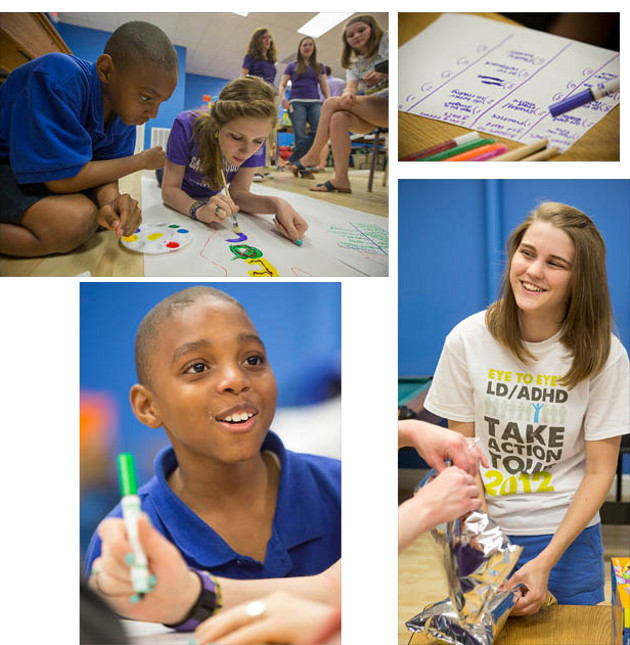The Human Touch Revealing All that is Real
Seeing 'Eye to Eye'
ECU students mentor youths facing similar learning disabilities
A group of students in East Carolina University’s Project STEPP program spent Friday afternoons this semester out in the community, mentoring fourth- and fifth-graders at the Building Hope Community Life Center. The kids listen and respond to their Pirate mentors. They have connected. And there’s a good reason for that.
Each of the students in Project STEPP has overcome a learning disability or ADHD to get to college. The kids they’re partnered with struggle against the same disabilities.
“The goal is to teach them things that we’ve learned,” said ECU junior Lee Olson, student coordinator of the Eye to Eye mentoring program. “We’ve all faced challenges throughout school and I think the biggest thing is just knowing that you can be successful and will make it to college.”

Eye to Eye is a national organization that provides support and training for the ECU chapter. The aim is to encourage students with learning disabilities or attention deficit hyperactivity disorder (ADHD) and get them excited about school and learning. The students in Project STEPP make the perfect match.
STEPP stands for Supporting Transition and Education through Planning and Partnerships, and has been housed in the College of Education at ECU since its inception in 2006. Administrators offer academic, social and life skills support to a select number of students with ADHD or learning disabilities in reading, writing or math.
Freshman STEPP student Emily Bosak compares living with a learning disability to running a race.
“Everyone's shoes are made out of lightweight leather but my shoes are made out of lead,” she said. ”So I am going to run the same race everyone else is and I am going to finish the race like everyone else but it is just going to take me a little bit longer. It doesn't mean I am not athletic or incapable of finishing the race, I just have something holding me back."
 She and the other Project STEPP students know well what the kids are experiencing at school. The interactions between mentor and mentee are often casual, and based around artistic activities that stimulate the young learners but don’t stress them out.
She and the other Project STEPP students know well what the kids are experiencing at school. The interactions between mentor and mentee are often casual, and based around artistic activities that stimulate the young learners but don’t stress them out.
At Building Hope one Friday in April, 10-year-old Jadaja Britton painted images representing her strengths and goals on a life-sized human outline – a purple shoe because she’s a good runner, a microphone because she likes to sing, a science book and a report card. As she worked, ECU freshman Brooke Carter asked what she was learning about in science.
“Ecosystems,” Jadaja replied, adding that she likes science class “because you get to try experiments.”
Nearby, Bosak and Marvion Wilcox, 10, had a conversation about primary colors. Though he quickly grasped that concept, the young man who plans to one day work as a dermatologist wasn’t ready to commit to the purple and gold.
“I still haven’t decided,” Marvion said when asked if he was going to attend ECU. He’s focused instead on a serious long-term goal: “I want to pass all my grades. I’m even talking about college grades!”
ECU student Chelsea Guild brought Eye to Eye to ECU in fall 2012 and still visits the group when she can. She said everyone involved in the mentoring process gets something out of it. That’s important, she added, because growing up with a disability can be lonely.
“You may feel like, ‘Why am I the only one being pulled out of my classroom?’ With this project, you’re included in a family of hope, included in a community.”
For many of the ECU students, it’s about giving something back.
“I had a speech and language pathologist, Alex, who made a huge difference in my life,” said Olson, who lives with dyslexia. “I thought there was no way I would make it through high school or college and she really motivated me to do it. She made learning fun for me, and that’s why I do this with the kids now. It’s motivating (the kids) to concentrate on school and keep up the good work.”
“It’s been fun,” said ECU freshman Matthew Lahey, who has an auditory processing disorder. “I want them to know they can do whatever they want. They can be whatever they want to be.”
The other Project STEPP students participating in Eye to Eye are Logan Jones, Ben Marshall, Becca O'Hea, Michael Whelan and Jared Goodrum.
They are advised by Dr. Sarah Williams, Project STEPP director, and Emily Johnson, associate director and transition specialist for Project STEPP.
For more information about Project STEPP at ECU, visit: http://www.ecu.edu/cs-educ/stepp/index.cfm.
More information about the Eye to Eye mentoring program is available at: http://eyetoeyenational.org/. Participating in after school activities at Building Hope were 10-year-old Marvion Wilcox, upper left, and ECU junior and Eye to Eye student coordinator Lee Olson, lower right. At lower left, Wilcox works with ECU freshman Emily Bosak. Handwritten goals in crayon are shown in the upper right.
Participating in after school activities at Building Hope were 10-year-old Marvion Wilcox, upper left, and ECU junior and Eye to Eye student coordinator Lee Olson, lower right. At lower left, Wilcox works with ECU freshman Emily Bosak. Handwritten goals in crayon are shown in the upper right.
Go Back
A group of students in East Carolina University’s Project STEPP program spent Friday afternoons this semester out in the community, mentoring fourth- and fifth-graders at the Building Hope Community Life Center. The kids listen and respond to their Pirate mentors. They have connected. And there’s a good reason for that.
Each of the students in Project STEPP has overcome a learning disability or ADHD to get to college. The kids they’re partnered with struggle against the same disabilities.
“The goal is to teach them things that we’ve learned,” said ECU junior Lee Olson, student coordinator of the Eye to Eye mentoring program. “We’ve all faced challenges throughout school and I think the biggest thing is just knowing that you can be successful and will make it to college.”

Eye to Eye is a national organization that provides support and training for the ECU chapter. The aim is to encourage students with learning disabilities or attention deficit hyperactivity disorder (ADHD) and get them excited about school and learning. The students in Project STEPP make the perfect match.
STEPP stands for Supporting Transition and Education through Planning and Partnerships, and has been housed in the College of Education at ECU since its inception in 2006. Administrators offer academic, social and life skills support to a select number of students with ADHD or learning disabilities in reading, writing or math.
Freshman STEPP student Emily Bosak compares living with a learning disability to running a race.
“Everyone's shoes are made out of lightweight leather but my shoes are made out of lead,” she said. ”So I am going to run the same race everyone else is and I am going to finish the race like everyone else but it is just going to take me a little bit longer. It doesn't mean I am not athletic or incapable of finishing the race, I just have something holding me back."

Jadaja Britton studies an outline of herself at the Building Hope after school program. Her next activity was to draw images on the outline to represent her strengths and goals.
At Building Hope one Friday in April, 10-year-old Jadaja Britton painted images representing her strengths and goals on a life-sized human outline – a purple shoe because she’s a good runner, a microphone because she likes to sing, a science book and a report card. As she worked, ECU freshman Brooke Carter asked what she was learning about in science.
“Ecosystems,” Jadaja replied, adding that she likes science class “because you get to try experiments.”
Nearby, Bosak and Marvion Wilcox, 10, had a conversation about primary colors. Though he quickly grasped that concept, the young man who plans to one day work as a dermatologist wasn’t ready to commit to the purple and gold.
“I still haven’t decided,” Marvion said when asked if he was going to attend ECU. He’s focused instead on a serious long-term goal: “I want to pass all my grades. I’m even talking about college grades!”
ECU student Chelsea Guild brought Eye to Eye to ECU in fall 2012 and still visits the group when she can. She said everyone involved in the mentoring process gets something out of it. That’s important, she added, because growing up with a disability can be lonely.
“You may feel like, ‘Why am I the only one being pulled out of my classroom?’ With this project, you’re included in a family of hope, included in a community.”
For many of the ECU students, it’s about giving something back.
“I had a speech and language pathologist, Alex, who made a huge difference in my life,” said Olson, who lives with dyslexia. “I thought there was no way I would make it through high school or college and she really motivated me to do it. She made learning fun for me, and that’s why I do this with the kids now. It’s motivating (the kids) to concentrate on school and keep up the good work.”
“It’s been fun,” said ECU freshman Matthew Lahey, who has an auditory processing disorder. “I want them to know they can do whatever they want. They can be whatever they want to be.”
The other Project STEPP students participating in Eye to Eye are Logan Jones, Ben Marshall, Becca O'Hea, Michael Whelan and Jared Goodrum.
They are advised by Dr. Sarah Williams, Project STEPP director, and Emily Johnson, associate director and transition specialist for Project STEPP.
For more information about Project STEPP at ECU, visit: http://www.ecu.edu/cs-educ/stepp/index.cfm.
More information about the Eye to Eye mentoring program is available at: http://eyetoeyenational.org/.
 Participating in after school activities at Building Hope were 10-year-old Marvion Wilcox, upper left, and ECU junior and Eye to Eye student coordinator Lee Olson, lower right. At lower left, Wilcox works with ECU freshman Emily Bosak. Handwritten goals in crayon are shown in the upper right.
Participating in after school activities at Building Hope were 10-year-old Marvion Wilcox, upper left, and ECU junior and Eye to Eye student coordinator Lee Olson, lower right. At lower left, Wilcox works with ECU freshman Emily Bosak. Handwritten goals in crayon are shown in the upper right.| Doing the Right Thing | East Carolina University, School News, The Region, Neighboring Counties | A One-Word Question at the Heart of the Debate |





















